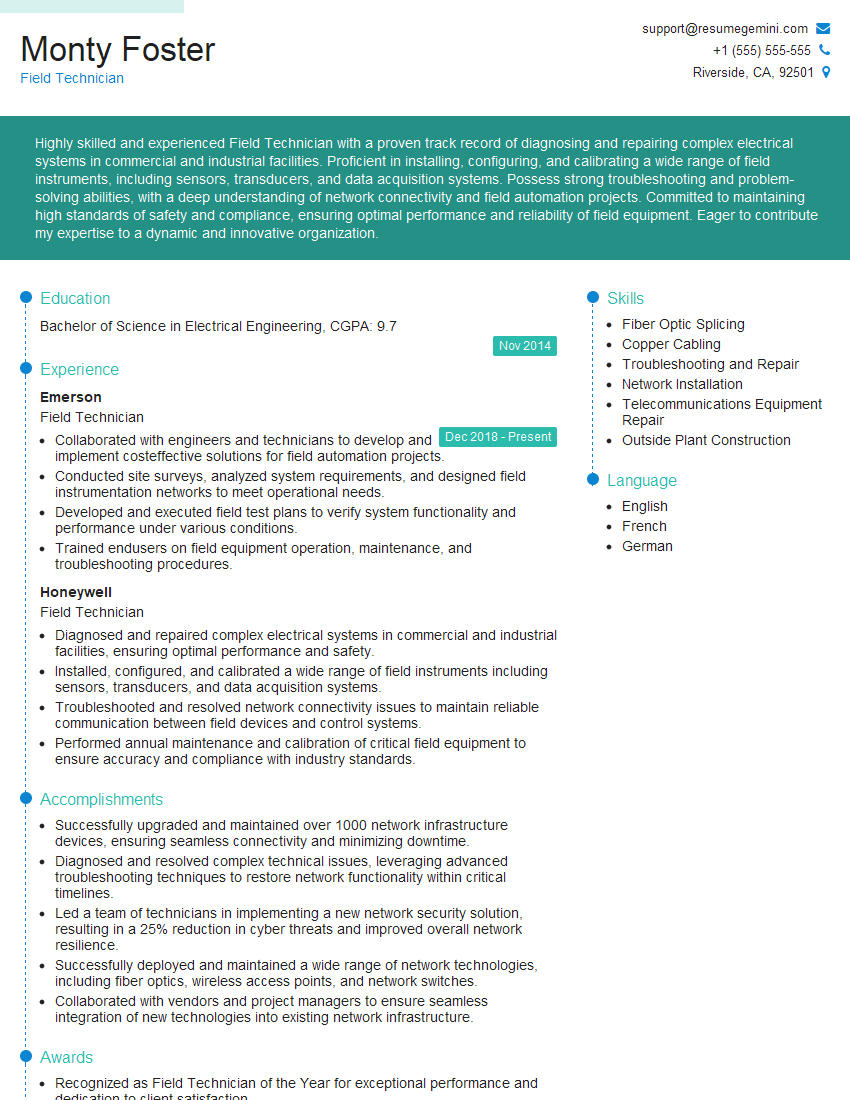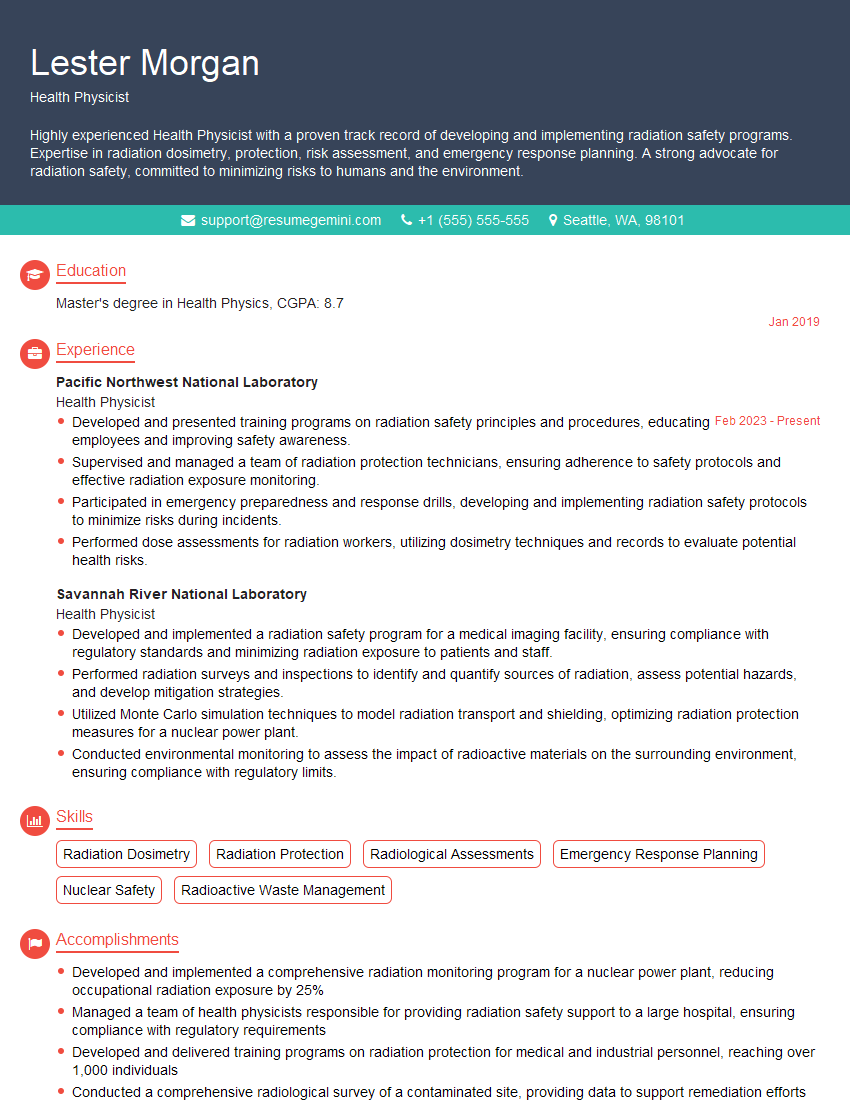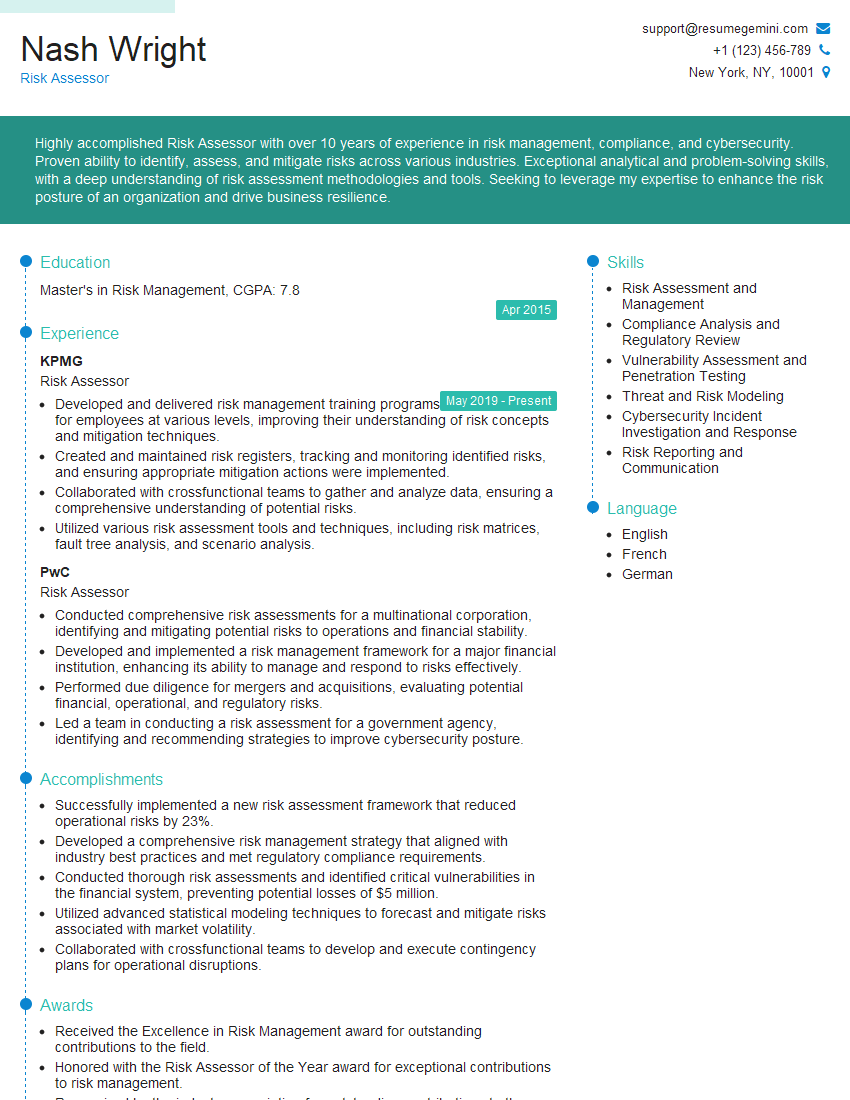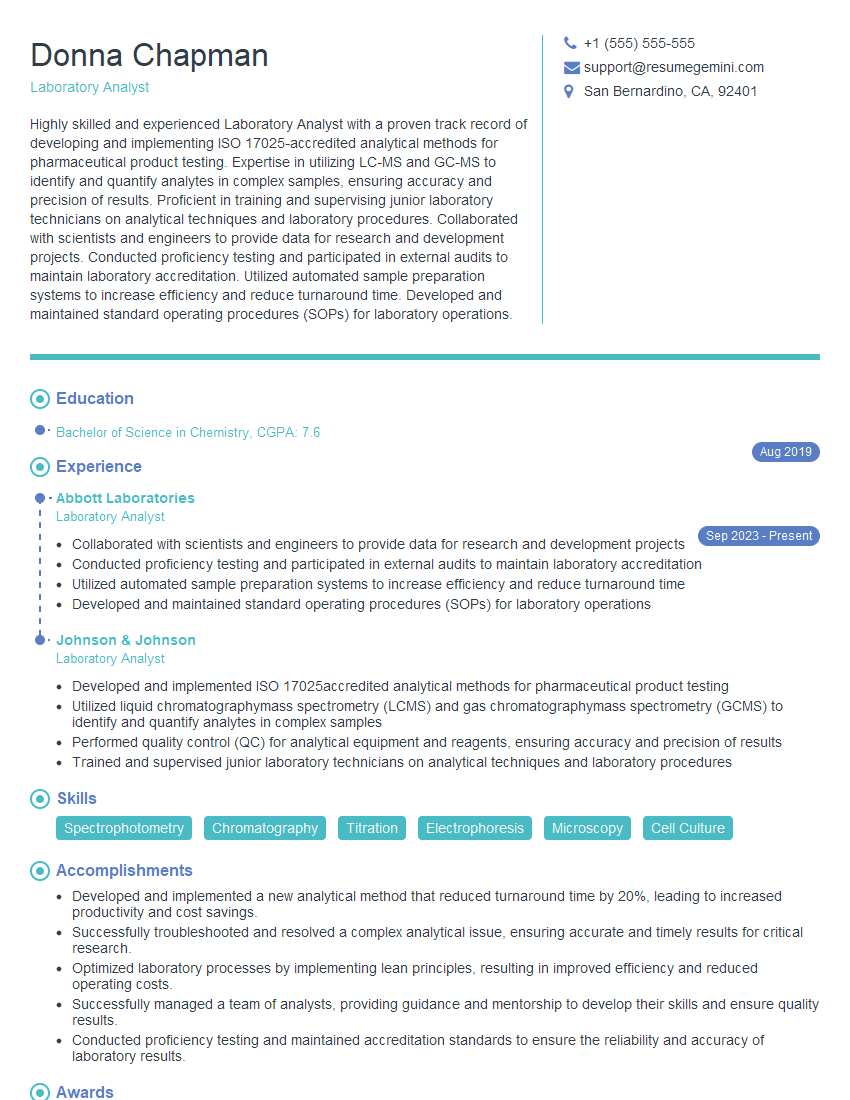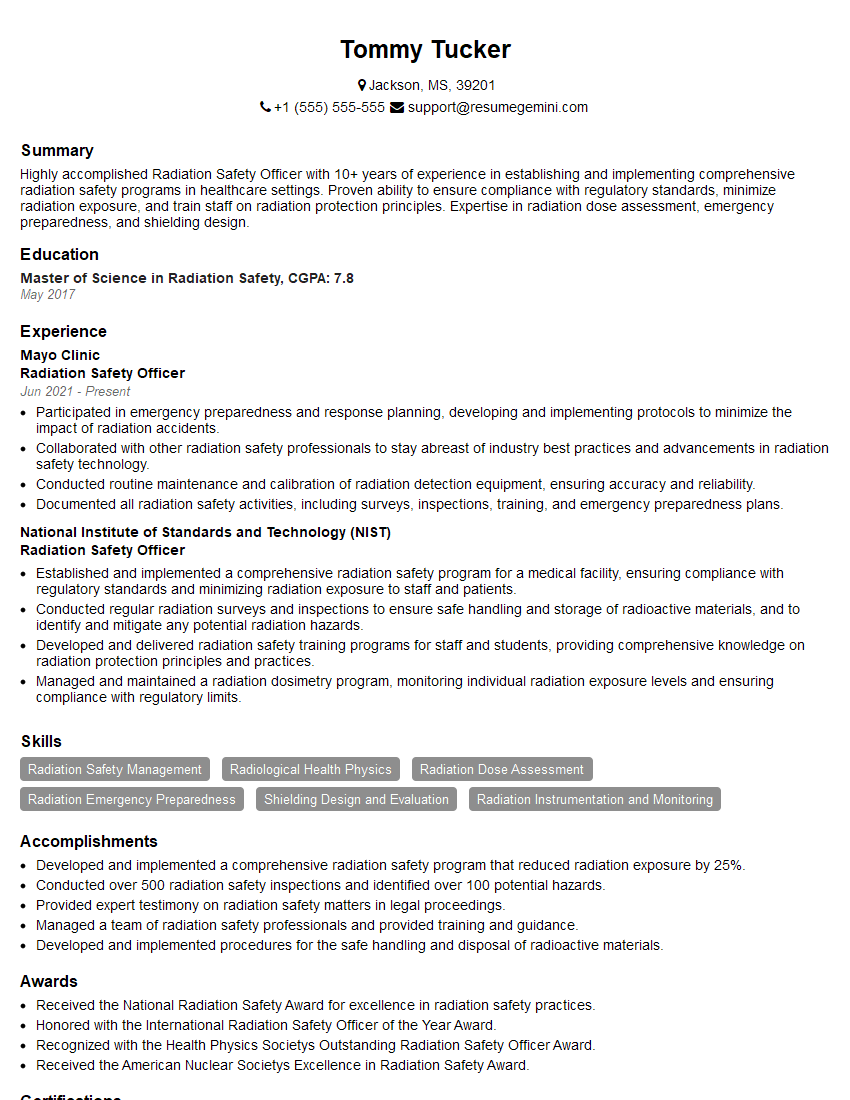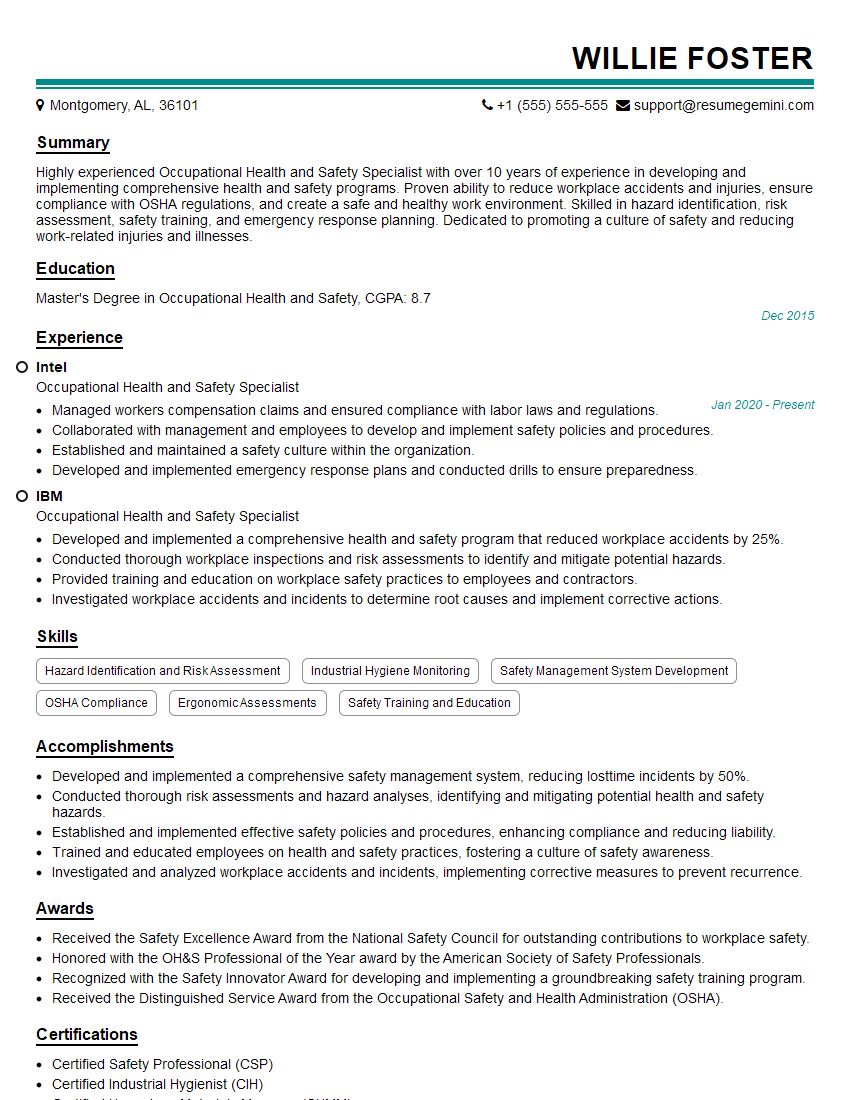The right preparation can turn an interview into an opportunity to showcase your expertise. This guide to Personal Sampling interview questions is your ultimate resource, providing key insights and tips to help you ace your responses and stand out as a top candidate.
Questions Asked in Personal Sampling Interview
Q 1. Describe the different types of personal sampling pumps.
Personal sampling pumps are the workhorses of air monitoring, drawing air through a sampling medium to collect airborne contaminants. They come in various types, categorized primarily by their flow rate control and power source.
- Diaphragm pumps: These are the most common, using a flexible diaphragm to create suction. They offer a good balance of flow rate control, portability, and cost-effectiveness. Think of them like a miniature heart pumping air through the system.
- Rotary vane pumps: These use a rotating vane within a cylinder to generate airflow. They tend to be more robust and capable of higher flow rates than diaphragm pumps, but are often larger and heavier. Imagine a tiny, precisely engineered fan drawing air.
- Peristaltic pumps: These pumps use rollers to squeeze a flexible tube, creating a pulsating flow. They are particularly useful for sampling viscous liquids or gases that could damage other pump types. Think of how you might squeeze a tube of toothpaste – the rollers mimic that action but for air.
- Battery-powered vs. AC-powered pumps: Pumps are further categorized by their power source. Battery-powered pumps offer greater portability, essential for field work, while AC-powered pumps are typically used in stationary settings or where a constant power supply is available.
The choice of pump type depends heavily on the specific application, considering factors such as required flow rate, sample duration, portability needs, and the nature of the analyte being sampled.
Q 2. Explain the principles of passive sampling.
Passive sampling relies on diffusion or permeation to collect airborne contaminants without the need for a pump. Instead of actively drawing air, it lets the contaminant move across a concentration gradient into a sorbent material. Imagine a sponge absorbing water – the water moves into the sponge passively due to its natural tendency to spread out.
The principle is straightforward: a sampling device containing a specific sorbent material is exposed to the air. The analyte diffuses or permeates into the sorbent at a rate determined by factors such as its concentration in the air, the diffusion coefficient of the analyte, and the properties of the sorbent material. The amount collected is then analyzed to estimate the time-weighted average concentration.
Passive samplers are particularly useful for long-term monitoring, providing time-weighted averages over extended periods. They are also typically smaller and lighter than active sampling pumps, making them more convenient for certain applications such as personal exposure monitoring in demanding environments. However, they are typically unsuitable for collecting highly reactive or unstable compounds.
Q 3. What are the limitations of personal sampling?
While incredibly valuable, personal sampling isn’t without limitations.
- Worker Participation and Compliance: The accuracy of personal sampling heavily relies on the worker correctly wearing the sampling device throughout their shift. Forgetting to wear it, or improper placement, can significantly impact results.
- Sampling Artifacts: The sampling process itself might introduce errors. For example, the worker’s movements or clothing could interfere with airflow patterns, leading to inaccurate measurements. We need to be mindful of interference in our ‘clean’ sample.
- Limited Analyte Range: Some compounds might not be effectively collected by available sampling media, restricting the technique’s application to specific chemicals.
- Cost and Time: Personal sampling, including pump calibration, media analysis, and data interpretation, can be time-consuming and expensive, particularly for large-scale studies.
- Data Interpretation: Analyzing the data to represent the worker’s actual exposure involves making assumptions about breathing rates and patterns, which might not always be entirely accurate. We use models to help us, but they can only be so precise.
Understanding these limitations helps us improve sampling design, minimize errors, and correctly interpret the results.
Q 4. How do you select the appropriate sampling media for a specific analyte?
Choosing the right sampling media is crucial for accurate results. The selection depends heavily on the physical and chemical properties of the analyte.
- Solid sorbents: These include charcoal tubes, silica gel, and various specialized resins. Charcoal is excellent for many organic compounds, while silica gel is good for polar compounds. The choice depends on the compound’s volatility and polarity.
- Filters: Filters capture particulate matter. The pore size and filter material (e.g., cellulose ester, glass fiber) are chosen based on the size and chemical properties of the particles.
- Impingers: These devices draw air through a liquid, capturing soluble analytes. The choice of impinger design and absorbing liquid depends on the analyte’s solubility and reactivity.
For example, to sample benzene (a volatile organic compound), a charcoal tube would be appropriate due to its high adsorption capacity for benzene. In contrast, for asbestos fibers (particulate matter), a filter with an appropriate pore size would be needed. Consulting relevant standard methods and safety data sheets is always recommended.
Q 5. Describe the process of calibrating a personal sampling pump.
Calibrating a personal sampling pump is essential to ensure accurate flow rate. This is typically done using a calibrated flow meter or a bubble meter.
- Prepare the pump: Attach a calibrated flow meter to the pump’s outlet.
- Set the flow rate: Set the pump to the desired flow rate (specified in the sampling method).
- Measure the flow rate: Allow the pump to run for a predetermined time (e.g., 1 minute), and record the flow rate displayed on the flow meter. Repeat this several times.
- Adjust if necessary: If the measured flow rate differs significantly from the desired flow rate, adjust the pump’s settings until the measured flow rate is within the acceptable tolerance (typically ±5%).
- Record calibration data: Record the date, time, flow rate, and pump serial number in a calibration log.
Regular calibration is crucial, typically before and after each sampling event and at least once per year.
Q 6. How do you ensure the integrity of a personal air sample?
Maintaining the integrity of a personal air sample is paramount. Contamination or loss of analyte can compromise the results.
- Proper Handling: Handle sampling media carefully to avoid contamination. Wear clean gloves and avoid touching the sampling surface.
- Sample Chain of Custody: Maintain a detailed record of sample handling, transport, and storage to ensure traceability. Think of it like a detective’s careful documentation of evidence.
- Appropriate Storage: Store samples under appropriate conditions to prevent analyte loss or degradation. This might involve refrigeration, freezing, or the use of desiccants.
- Sample Blanks and Field Blanks: Include blanks in the sampling process to account for potential contamination from sampling equipment or the environment. Field blanks are particularly important.
- Proper Sealing: After sample collection, seal the sampling media appropriately to prevent leakage or contamination during transport and storage.
Following these steps ensures reliable and accurate results, preventing the need for repeat sampling. A compromised sample leads to wasted resources and inconclusive results.
Q 7. What are the safety precautions associated with personal sampling?
Safety is paramount in personal sampling.
- Hazardous Substances: Always be aware of potential hazards associated with the analytes being sampled. Consult Safety Data Sheets (SDS) and use appropriate personal protective equipment (PPE).
- Pump Safety: Ensure the pump is properly maintained and that the power source is safe. Don’t overload the battery or operate the pump in unsafe environments.
- Ergonomics: Choose a sampling pump and harness that’s comfortable and easy to wear, to ensure the worker can safely carry out their work.
- Calibration Safety: When calibrating pumps, follow the manufacturer’s instructions carefully and ensure you’re operating the flow meter correctly to avoid injury.
- Training: All personnel involved in personal sampling should receive adequate training on the safe handling of equipment, sampling procedures, and potential hazards.
Prioritizing safety not only protects the sampler but also safeguards the validity and reliability of the collected data.
Q 8. Explain the importance of chain of custody in personal sampling.
Chain of custody in personal sampling is crucial for ensuring the integrity and admissibility of sampling data. It’s a documented process that tracks the sample from the moment it’s collected to its final analysis and disposal. Think of it like a relay race – each person handling the sample is a runner, and the chain of custody is the baton. If the baton is dropped (sample compromised), the race (data validity) is compromised.
A complete chain of custody includes detailed records of who collected the sample, when and where it was collected, who transported and stored it, and who analyzed it. Any transfers must be documented, along with any changes in sample condition. This rigorous documentation prevents tampering, ensures accuracy, and maintains the legal validity of the results in case of any disputes or legal proceedings. For example, if a worker claims an exposure level was lower than what was reported, a well-maintained chain of custody provides irrefutable evidence to support the findings.
- Sample collection: Detailed information on the worker, location, date, and time.
- Sample handling: Information on each person who handled the sample, the date, time, and any changes in sample condition.
- Sample analysis: Details on the laboratory, analytical methods used, and the analyst.
- Sample disposal: Documentation of proper disposal procedures.
Q 9. How do you calculate the time-weighted average (TWA) exposure?
The time-weighted average (TWA) exposure represents the average airborne concentration of a substance over a specified period, typically an 8-hour workday. It accounts for variations in exposure levels throughout the day. Imagine a worker exposed to a chemical at different concentrations throughout their shift; the TWA provides a single representative value for their overall exposure.
The calculation involves summing the product of the concentration and duration at each sampling period, and then dividing by the total sampling time. For example:
TWA = (C1 * T1 + C2 * T2 + ... + Cn * Tn) / TtotalWhere:
C1, C2, ..., Cnare the concentrations measured at different time intervals.T1, T2, ..., Tnare the durations of those time intervals.Ttotalis the total sampling time.
Let’s say a worker was exposed to a chemical at 10 ppm for 2 hours, 20 ppm for 3 hours, and 5 ppm for 3 hours. The TWA would be:
TWA = (10 ppm * 2 hours + 20 ppm * 3 hours + 5 ppm * 3 hours) / 8 hours = 12.5 ppmQ 10. What are the common sources of error in personal sampling?
Errors in personal sampling can stem from various sources, impacting the accuracy and reliability of the results. It’s crucial to identify and minimize these errors to ensure valid conclusions.
- Sampling error: Incorrect sampler placement, leaks in the sampling system, or improper flow rate adjustment can lead to underestimation or overestimation of exposure.
- Analytical error: Inaccurate calibration of instruments, improper handling of samples during laboratory analysis, and incorrect use of analytical methods can affect the concentration determination.
- Worker compliance: The worker’s actions, such as removing the sampler or failing to wear it properly, directly affect sample integrity.
- Environmental factors: Extreme temperatures, humidity, or dust can interfere with sample collection and analysis.
- Sampling media limitations: The chosen sampler might not be appropriate for the specific substance or concentration range.
For instance, a poorly calibrated pump can deliver an incorrect flow rate, resulting in the under- or over-collection of the target analyte. Similarly, if the sampler is not positioned correctly near the worker’s breathing zone, the result will not accurately reflect the worker’s exposure.
Q 11. How do you deal with unexpected results in personal sampling?
Unexpected results in personal sampling require a systematic investigation to determine the cause. Simply dismissing them is unacceptable. A thorough review of the entire process is crucial.
- Review sampling procedure: Check for any deviations from the established protocol during sample collection, handling, and analysis. Were the correct methods and equipment used? Was the chain of custody maintained?
- Analyze the data: Review the raw data for anomalies or inconsistencies. Are there any outliers that might indicate errors?
- Investigate potential errors: Consider all possible sources of error: was there a problem with the pump calibration? Could there have been leaks? Was the sampler positioned incorrectly? Were the analytical techniques performed correctly?
- Repeat sampling: If needed, repeat the sampling process to verify the initial findings. Take the precautions learned from the initial investigation.
- Consult with experts: If the cause remains unclear, consult with experts in industrial hygiene or analytical chemistry.
For instance, if the results show unusually high exposure levels, a review of the worker’s activities, the sampling location, and the analysis method is needed to assess whether these results accurately reflect reality or point to an error. A re-sampling event might be warranted.
Q 12. Describe your experience with different types of personal samplers (e.g., sorbent tubes, filters).
My experience encompasses a wide range of personal samplers, each suited for specific applications. The choice of sampler depends on the target analyte, its properties, and the expected concentration.
- Sorbent tubes: These are widely used for collecting gaseous and vapor-phase contaminants. I’ve extensively used them for collecting organic solvents, pesticides, and other volatile compounds. The type of sorbent material (e.g., charcoal, silica gel) is crucial for effective adsorption of the target compound.
- Filters: Filters are ideal for collecting particulate matter, including dust, fibers, and fumes. Different filter types (e.g., cellulose ester, quartz) cater to specific particle sizes and chemical compositions. I have experience with various filter types for asbestos analysis, silica dust monitoring, and metal fume assessments.
- Impingers: These devices are used for collecting both particulate and gaseous contaminants by bubbling the air sample through a liquid. I’ve used impingers to collect certain gases and aerosols that might not be adequately captured by other samplers. They are very useful when dealing with highly soluble compounds
- Badges: Passive sampling devices offer simplicity and ease of use and are convenient for longer-term monitoring.
My experience includes selecting the appropriate sampler based on the specific needs of the project, ensuring proper calibration and use, and performing the necessary post-sampling handling and analytical techniques.
Q 13. Explain the differences between active and passive personal sampling.
Active and passive personal sampling methods differ primarily in how the air is drawn into the sampler.
- Active sampling: Uses a pump to draw a known volume of air through the sampling media at a controlled flow rate. This provides precise control over the sampling volume and allows for accurate calculation of TWA exposures. Think of it as actively ‘sucking’ the air into the sampler.
- Passive sampling: Relies on diffusion to draw air into the sampler. It’s simpler and less intrusive, often requiring no external power source. However, it is less accurate than active sampling because the sampling rate is dependent on environmental factors (temperature, humidity, air movement). This is like allowing the air to diffuse into the sampler over time.
Active sampling is generally preferred for higher accuracy and precise exposure assessments, while passive sampling is more convenient for long-term monitoring and where worker comfort is paramount.
Q 14. How do you determine the appropriate sampling flow rate?
Determining the appropriate sampling flow rate is essential for accurate exposure assessments. The flow rate should be optimized to capture a sufficient mass of the contaminant while avoiding breakthrough (where the contaminant passes through the sampling media without being captured) or saturation. There are various factors to consider:
- Type of sampler: Different samplers have different recommended flow rates. This information is usually supplied by the manufacturer.
- Target analyte: Some contaminants require higher flow rates for adequate collection, while others might require lower flow rates to prevent breakthrough.
- Expected concentration: Higher concentrations may necessitate a lower flow rate to avoid saturating the sampler.
- Sampling duration: The desired sampling time influences the flow rate; a longer sampling time permits lower flow rates while still collecting an adequate sample.
The flow rate is often specified in the sampling method or determined using empirical data. It’s crucial to maintain a constant flow rate throughout the sampling period and accurately measure and record it for later calculations. Flow rate calibration is a standard practice to validate and correct any deviation.
Q 15. What are the legal and regulatory requirements for personal sampling in your area?
Legal and regulatory requirements for personal sampling vary significantly depending on location and the specific substance being sampled. In my region, we primarily adhere to OSHA (Occupational Safety and Health Administration) regulations in the US, and equivalent regulations in other countries. These regulations dictate permissible exposure limits (PELs) for various hazardous substances. For example, OSHA sets PELs for asbestos, lead, and various solvents. These PELs define the maximum allowable concentration of a substance in the air over a specified period (e.g., 8-hour time-weighted average). Failure to comply with these regulations can lead to significant penalties, including fines and legal action. Beyond PELs, regulations also cover aspects like sampling methods, analytical techniques, quality control, and record-keeping. We are also required to follow strict chain of custody protocols to ensure sample integrity and legal admissibility of results. Staying updated on these regulations is crucial; we regularly review and implement changes to our protocols to maintain compliance. For instance, recent updates regarding silica dust monitoring require specialized sampling techniques and analytical methods, necessitating adjustments to our procedures.
Career Expert Tips:
- Ace those interviews! Prepare effectively by reviewing the Top 50 Most Common Interview Questions on ResumeGemini.
- Navigate your job search with confidence! Explore a wide range of Career Tips on ResumeGemini. Learn about common challenges and recommendations to overcome them.
- Craft the perfect resume! Master the Art of Resume Writing with ResumeGemini’s guide. Showcase your unique qualifications and achievements effectively.
- Don’t miss out on holiday savings! Build your dream resume with ResumeGemini’s ATS optimized templates.
Q 16. Describe your experience with data analysis and reporting in personal sampling.
My experience with data analysis and reporting in personal sampling is extensive. I’m proficient in using statistical software packages such as R and Excel to analyze the data generated from personal air sampling. This involves calculating time-weighted averages (TWAs), peak exposures, and other relevant statistical parameters. I’m also adept at generating comprehensive reports that include raw data, calculated results, comparisons to regulatory limits, and interpretations of the findings. For instance, I recently analyzed data from a silica dust sampling campaign involving 50 workers. I used R to calculate TWAs for each worker, compared them to the OSHA PEL, and generated a report detailing the results, including identifying workers exceeding the PEL and recommending corrective actions. The report also included a detailed description of the sampling methodology, quality control procedures, and limitations of the study. Data visualization is a key aspect of my reporting; I use graphs and charts to present findings clearly and concisely, making it easy for clients and stakeholders to understand the results and their implications. Clear and accurate reporting is essential for demonstrating compliance with regulations and identifying areas needing improvement.
Q 17. How do you ensure the accuracy and precision of personal sampling results?
Ensuring the accuracy and precision of personal sampling results is paramount. We achieve this through a multifaceted approach encompassing meticulous planning, rigorous quality control, and proficient analytical techniques. This starts with proper selection of sampling equipment, calibration of instruments (e.g., pumps, flow meters), and careful selection of appropriate sampling media. We employ rigorous quality control measures such as blank samples (to detect contamination) and duplicate samples (to assess precision) throughout the sampling process. Furthermore, we utilize validated analytical methods with documented accuracy and precision. For example, we use certified reference materials to regularly calibrate our analytical instruments and validate the accuracy of our methods. We maintain detailed records of all aspects of the sampling and analysis process to ensure traceability and auditability. For example, a well-maintained chain of custody document tracks the sample from collection to analysis, documenting each step and ensuring accountability. A regular review and update of Standard Operating Procedures (SOPs) are integral parts of the continuous improvement process which aims to maximize accuracy and minimize sources of error.
Q 18. How do you handle sample contamination?
Sample contamination is a significant concern in personal sampling. We mitigate this risk through several strategies. Before sampling, we meticulously clean all sampling equipment to remove any potential contaminants. We use appropriate cleaning solvents and procedures based on the nature of the contaminant, ensuring that the cleaning process itself doesn’t introduce other contaminants. We also carefully select sampling locations to minimize the risk of cross-contamination. For example, we might use different sampling pumps for different workers or substances. Proper handling and storage of samples are also critical. Samples are transported in clean, sealed containers to prevent contamination during transit. During analysis, we use clean laboratory equipment and maintain a clean working environment. We also use blank samples to assess background contamination levels, and we deduct the blank values from the measured sample concentrations. In case of suspected contamination, we would repeat the sampling or analysis and investigate the source of the contamination. Documentation of all steps is vital, allowing for traceability in case of contamination issues.
Q 19. What are the different types of personal protective equipment (PPE) used in personal sampling?
Personal protective equipment (PPE) in personal sampling depends heavily on the specific hazards present. It’s crucial to perform a thorough hazard assessment before selecting PPE. Common PPE includes:
- Respirators: Various types, from half-mask to full-face respirators, are used depending on the respiratory hazard. Proper fit testing is essential.
- Gloves: Different glove materials (nitrile, latex, etc.) offer varying degrees of protection against different chemicals.
- Safety Glasses or Goggles: To protect eyes from splashes or airborne particles.
- Protective Clothing: Tyvek suits, coveralls, lab coats, etc., depending on the potential for skin exposure to hazardous substances.
- Hearing Protection: If noise levels are elevated during sampling.
Q 20. Describe your experience with different analytical methods used for personal sampling.
My experience encompasses several analytical methods used in personal sampling, each suited for different substances and concentrations. For example, we use gas chromatography-mass spectrometry (GC-MS) for volatile organic compounds (VOCs), high-performance liquid chromatography (HPLC) for many non-volatile compounds, and inductively coupled plasma-mass spectrometry (ICP-MS) for metals. We also employ gravimetric analysis for dust sampling. The choice of analytical method depends on the analyte’s chemical properties, the expected concentration range, and the required level of sensitivity and specificity. I’m proficient in using and validating these techniques. For instance, I recently validated a new HPLC method for analyzing a novel pesticide in a workplace air sampling study. This involved testing the method’s accuracy, precision, linearity, and limit of detection. Method validation is critical to ensuring reliable results and compliance with regulatory requirements. Data quality control is a crucial part of the analytical process. We use internal and external standards, control samples, and blank samples to maintain accuracy and precision throughout the analytical procedures.
Q 21. Explain the concept of uncertainty in personal sampling.
Uncertainty in personal sampling refers to the range of values within which the true value of the measurement likely falls. It’s not simply about random error but encompasses all potential sources of variability, including sampling error, analytical error, and calibration uncertainty. A good analogy would be throwing darts at a dartboard. Even a skilled player doesn’t hit the bullseye every time. Some darts will be clustered near the center, but others will be scattered around. The uncertainty represents the overall spread of those darts. In personal sampling, uncertainty arises from various sources: inaccurate flow rates in pumps, incomplete collection of the target analyte on the sampling media, and variability in the analytical method. We express uncertainty using confidence intervals, which provide a range of values within which we are confident the true value lies (e.g., 95% confidence interval). Properly characterizing uncertainty is essential for interpreting results and making informed decisions based on the data. Underestimating uncertainty can lead to misinterpretations and potentially unsafe working conditions, whereas overestimating uncertainty may lead to unnecessary actions. We routinely assess and report uncertainties, ensuring transparent communication of the limitations associated with our measurements.
Q 22. How do you assess the quality of your personal sampling data?
Assessing the quality of personal sampling data is crucial for ensuring the reliability and validity of our findings. It’s a multi-faceted process that begins even before sampling begins. We need to ensure the integrity of the entire process, from instrument calibration and selection to sample analysis and data reporting.
Calibration and Instrument Checks: Before any sampling, we meticulously check and calibrate all equipment, including pumps, samplers, and analytical instruments. Documentation of these checks is paramount, often involving traceable calibration certificates and detailed logs. For example, a pump’s flow rate needs to be within a specified tolerance, and this is verified using a primary standard flow calibrator and recorded.
Blank Samples and Field Blanks: We use blank samples (media exposed to nothing but ambient air) and field blanks (media handled in the field, mimicking sample collection but containing no analyte) to identify potential contamination sources. Elevated concentrations in blanks would invalidate the data.
Sample Handling and Chain of Custody: Maintaining a rigorous chain of custody is essential to ensure that samples remain untampered with. This involves detailed documentation at each step, from sample collection to laboratory analysis, noting who handled the sample and when. Chain of custody forms track every transfer of the sample.
Data Analysis and QA/QC: We carefully review the data for outliers or inconsistencies, using statistical methods to identify potential errors. Duplicate samples and spiked samples (samples with known concentrations of the target analyte added) are frequently used for quality control. Significant deviations trigger further investigation.
Laboratory Accreditation: Ideally, the laboratory performing the analysis is accredited to relevant standards (e.g., ISO 17025), providing an extra layer of assurance regarding the quality of the analytical process.
By meticulously addressing each of these areas, we can confidently assess and ensure the high quality of our personal sampling data.
Q 23. Describe your experience with quality control and quality assurance in personal sampling.
Quality control (QC) and quality assurance (QA) are integral to every aspect of personal sampling, ensuring the accuracy, reliability, and validity of results. My experience involves implementing and adhering to comprehensive QC/QA protocols at each stage.
Pre-Sampling QA: This involves selecting appropriate sampling methods based on the target analyte, worker exposure levels, and the work environment. Proper training for samplers is also vital. We ensure that samplers are proficient in the use of equipment, sampling techniques, and safety procedures.
In-Field QC: During sampling, we regularly check pump flow rates, sample media integrity, and proper sample handling. Any deviation from established protocols is documented and investigated. For instance, a sudden drop in pump flow rate might indicate a clogged filter, necessitating immediate action.
Post-Sampling QC: The laboratory analysis phase incorporates QC checks such as blank samples, duplicate samples, and spiked samples to assess accuracy and precision. Data is checked for outliers and inconsistencies before reporting.
Audits: Regular audits of the entire process ensure compliance with relevant safety standards and best practices. Audits might involve internal reviews or external audits by regulatory bodies. This helps identify areas for improvement and maintain consistent high quality.
By diligently applying these QC/QA practices, we minimize errors and uncertainties, resulting in reliable and defensible data that supports informed decision-making.
Q 24. How do you interpret personal sampling results?
Interpreting personal sampling results involves more than simply looking at the numbers. It requires understanding the context, including the sampling strategy, the analytical method used, and relevant exposure limits.
Comparison to Exposure Limits: The most immediate interpretation compares the measured concentrations to relevant occupational exposure limits (OELs) such as the Permissible Exposure Limit (PEL) or the Recommended Exposure Limit (REL). Exceedances trigger investigation into control measures.
Statistical Analysis: Statistical analysis, including calculating averages, standard deviations, and percentiles, provides a more comprehensive understanding of the exposure pattern. This allows for a clearer picture of variability and potential peaks in exposure.
Data Trends and Patterns: Examining trends and patterns over time (for repeated sampling) helps identify potential exposure sources and assess the effectiveness of control measures. For instance, a reduction in exposure after implementing a ventilation system is easily observable.
Considering the Context: We must consider the specific tasks performed during sampling, the duration of exposure, and any other relevant factors. For example, a high concentration of a specific chemical may only be recorded during a short, specific task in a work shift.
Through careful consideration of these aspects, we translate raw data into meaningful insights that inform risk assessment and the development of effective exposure control strategies.
Q 25. Explain the importance of proper documentation in personal sampling.
Proper documentation is the backbone of any credible personal sampling project. It ensures traceability, accountability, and the defensibility of the results. Incomplete or inaccurate documentation can undermine the entire process.
Sampling Plan: A detailed sampling plan should specify objectives, sampling locations, sampling methods, analytical procedures, and QA/QC measures. This serves as a roadmap for the entire process.
Chain of Custody: As mentioned previously, maintaining a complete chain of custody document is essential. This includes details of sample collection, handling, transport, and analysis. This is crucial for legal reasons and maintaining data integrity.
Calibration Records: All equipment calibration data, including dates, results, and calibration certificates, must be meticulously documented. This ensures traceability and compliance.
Analytical Data and Reports: Raw data from laboratory analyses, along with any calculations or interpretations, should be included in comprehensive reports. These reports are the official record of the project.
Non-conformances and Corrective Actions: Any deviations from the established procedures or unexpected issues (e.g., equipment malfunctions) must be documented, along with the corrective actions taken. This ensures transparency and allows for learning from any errors.
Thorough documentation provides an audit trail, facilitating future reference, validation, and supporting informed decision-making based on the reliable results.
Q 26. How do you communicate your findings from personal sampling to non-technical audiences?
Communicating complex technical data to non-technical audiences, such as management or workers, requires clear, concise language, avoiding jargon. Visual aids are powerful tools.
Simplified Language: Avoid technical terms; use everyday language to explain findings. Instead of saying ‘the TWA exceeded the PEL,’ say ‘The average exposure level was higher than the safety limit.’
Visualizations: Graphs, charts, and diagrams are excellent for conveying information quickly and easily. A simple bar chart showing average exposure levels compared to the OEL is far more impactful than a table of numbers.
Analogies and Real-world Examples: Relate findings to relatable situations to aid comprehension. For instance, compare exposure levels to familiar substances like sugar in a drink.
Focus on Key Findings: Highlight the most important results and their implications, avoiding overwhelming the audience with unnecessary detail. Focus on action points and recommendations.
Interactive Presentations: Presentations with Q&A sessions encourage engagement and allow for clarification.
Effective communication ensures that everyone understands the risks and the actions needed to mitigate them. We need to ensure that everyone is involved and understands the importance of the results. This builds trust and cooperation.
Q 27. Describe a time you had to troubleshoot a problem during a personal sampling project.
During a personal sampling project at a manufacturing plant, we encountered unexpected high concentrations of a particulate matter during a specific task. This task was initially believed to have minimal exposure potential. The initial results seemed inconsistent with observations. We needed to identify the source of this discrepancy.
Troubleshooting Steps: First, we reviewed the sampling procedures, equipment calibrations, and laboratory analysis to rule out any errors. This confirmed that our equipment was calibrated correctly.
On-Site Investigation: Next, we conducted a thorough on-site investigation, observing the task closely and identifying potential sources of contamination. We discovered that a specific operation involved breaking open containers of powder, which generated a considerable dust cloud.
Modified Sampling Strategy: Based on our findings, we modified the sampling strategy, focusing more accurately on the dust generation point to ascertain the true nature of the exposure and implement appropriate control measures.
Re-sampling and Analysis: With the refined sampling strategy, we re-sampled and found that the earlier results weren’t entirely inaccurate, but the sampling technique was not adequately capturing the high transient concentrations. The re-sampling confirmed our hypothesis regarding the dust generation point.
This experience highlights the importance of thorough investigation, adaptability, and the need to continually refine our methodologies in the face of unexpected results. It underscores the need for careful observation and the iterative nature of the problem-solving process in personal sampling.
Key Topics to Learn for Personal Sampling Interview
- Sampling Strategies: Understand different sampling methods (passive vs. active, direct-reading instruments vs. sorbent tubes), their applications, and limitations. Consider scenarios where each method would be most appropriate.
- Calibration and Validation: Grasp the importance of instrument calibration and data validation. Be prepared to discuss quality control procedures and error analysis in the context of personal sampling.
- Health and Safety Regulations: Familiarize yourself with relevant OSHA, NIOSH, or other regulatory guidelines concerning personal sampling procedures and worker safety. Understanding legal implications is crucial.
- Data Analysis and Interpretation: Know how to interpret collected data, calculate exposure levels, and present findings in a clear and concise manner. Practice using relevant software or spreadsheets for data management.
- Specific Analytes and Methods: Depending on your target role, focus on the specific analytes and sampling methods relevant to the industry (e.g., asbestos, silica, VOCs). Be prepared to discuss the challenges and best practices associated with these.
- Instrumentation and Equipment: Demonstrate familiarity with common personal sampling equipment, including pumps, samplers, and detectors. Be prepared to discuss their operation, maintenance, and troubleshooting.
- Practical Application: Consider real-world case studies. How would you approach a personal sampling project? What steps would you take to ensure accuracy and reliability?
Next Steps
Mastering personal sampling opens doors to exciting career opportunities in occupational hygiene, environmental monitoring, and industrial safety. A strong understanding of these principles is highly valued by employers. To maximize your job prospects, invest time in crafting an ATS-friendly resume that showcases your skills and experience effectively. ResumeGemini is a trusted resource that can help you create a professional and impactful resume tailored to the specific requirements of personal sampling roles. Examples of resumes optimized for personal sampling positions are available to help you get started.
Explore more articles
Users Rating of Our Blogs
Share Your Experience
We value your feedback! Please rate our content and share your thoughts (optional).
What Readers Say About Our Blog
Hi, I have something for you and recorded a quick Loom video to show the kind of value I can bring to you.
Even if we don’t work together, I’m confident you’ll take away something valuable and learn a few new ideas.
Here’s the link: https://bit.ly/loom-video-daniel
Would love your thoughts after watching!
– Daniel
This was kind of a unique content I found around the specialized skills. Very helpful questions and good detailed answers.
Very Helpful blog, thank you Interviewgemini team.







